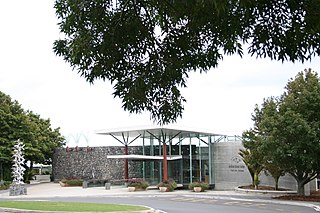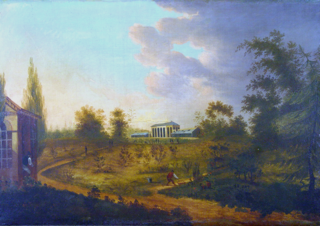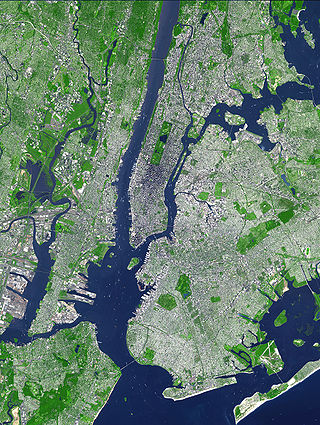
Winterthur Museum, Garden and Library is an American estate and museum in Winterthur, Delaware. Pronounced “winter-tour," Winterthur houses one of the richest collections of Americana in the United States. The museum and estate were the home of Henry Francis du Pont (1880–1969), Winterthur's founder and a prominent antiques collector and horticulturist.

Brooklyn Botanic Garden (BBG) is a botanical garden in the borough of Brooklyn, New York City. It was founded in 1910 using land from Mount Prospect Park in central Brooklyn, adjacent to Prospect Park and the Brooklyn Museum. The 52-acre (21 ha) garden holds over 14,000 taxa of plants and has nearly a million visitors each year. It includes a number of specialty "gardens within the Garden", plant collections, the Steinhardt Conservatory that houses the C. V. Starr Bonsai Museum, three climate-themed plant pavilions, a white cast-iron-and-glass aquatic plant house, and an art gallery.

An arboretum is a botanical collection composed exclusively of trees of a variety of species. Originally mostly created as a section in a larger garden or park for specimens of mostly non-local species, many modern arboreta are in botanical gardens as living collections of woody plants and is intended at least in part for scientific study.

The New York Botanical Garden (NYBG) is a botanical garden at Bronx Park in the Bronx, New York City. Established in 1891, it is located on a 250-acre (100 ha) site that contains a landscape with over one million living plants; the Enid A. Haupt Conservatory, a greenhouse containing several habitats; and the LuEsther T. Mertz Library, which contains one of the world's largest collections of botany-related texts. As of 2016, over a million people visit the New York Botanical Garden annually.

The Arnold Arboretum of Harvard University is a botanical research institution and free public park, located in the Jamaica Plain and Roslindale neighborhoods of Boston, Massachusetts. Established in 1872, it is the oldest public arboretum in North America. The landscape was designed by Charles Sprague Sargent and Frederick Law Olmsted and is the second largest "link" in the Emerald Necklace. The Arnold Arboretum's collection of temperate trees, shrubs, and vines has a particular emphasis on the plants of the eastern United States and eastern Asia, where arboretum staff and colleagues are actively sourcing new material on plant collecting expeditions. The arboretum supports research in its landscape and in its Weld Hill Research Building.

Coastal Maine Botanical Gardens is a botanical garden in Boothbay, Maine. It was opened in 2007.

The Connecticut College Arboretum is a 300 ha arboretum and botanical gardens, founded in 1931, and located on the campus of Connecticut College and in the towns of New London and Waterford, Connecticut, United States.
Mountain Top Arboretum, located in Tannersville, New York, United States is located in New York's Catskill Mountains.
Hidden Lake Gardens colloquially known as Hidden Lake 755 acres (3.06 km2), is a botanical garden and an arboretum operated by Michigan State University situated in the Irish Hills of southeast Michigan. The Gardens are known for their large collection of native and nonnative trees, shrubs and flowers. HLG was given to Michigan State University by Harry Fee in 1945. Today it is visited by nearly 45,000 people annually. Hidden Lake Gardens mission is to "preserve and enhance the natural beauty of the gardens and to display plants for the inspiration and education of the public".

Clark Botanic Garden is a 12-acre (4.9 ha) botanical garden and park located in Roslyn Heights, in Nassau County, on Long Island, in New York, United States.

Bronx Park is a public park along the Bronx River, in the Bronx, New York City. The park is bounded by Southern Boulevard to the southwest, Webster Avenue to the northwest, Gun Hill Road to the north, Bronx Park East to the east, and East 180th Street to the south. With an area of 718 acres (2.91 km2), Bronx Park is the eighth-largest park in New York City.

The University of Wisconsin–Madison Arboretum is a teaching and research facility of the University of Wisconsin–Madison and the site of historic research in ecological restoration. In addition to its 1,260 acres (5 km2) in Madison, Wisconsin, the Arboretum also manages 520 acres (210 ha) of remnant forests and prairies throughout Wisconsin. It was designated a National Historic Landmark in 2021, in recognition for its role as a pioneer in the field of ecological restoration.

The Cornell Botanic Gardens is a botanical garden located adjacent to the Cornell University campus in Ithaca, New York. The Botanic Gardens proper consist of 25 acres (10 ha) of botanical gardens and 150 acres (61 ha) of the F. R. Newman Arboretum. The greater Botanic Gardens includes 40 different nature areas around Cornell and Ithaca, covering 4,300 acres (1,700 ha).

Cheekwood is a 55-acre (22 ha) historic estate on the western edge of Nashville, Tennessee that houses the Cheekwood Estate & Gardens. Formerly the residence of Nashville's Cheek family, the 30,000-square-foot (2,800 m2) Georgian-style mansion was opened as a botanical garden and art museum in 1960.

The Dallas Arboretum and Botanical Garden is a 66-acre (27 ha) botanical garden located at 8525 Garland Road in East Dallas, Texas, on the southeastern shore of White Rock Lake.

Auckland Botanic Gardens is a botanical garden in the New Zealand city of Auckland. It is located in the suburb of Manurewa, in the Manurewa Local Board Area. The gardens cover 64 hectares, and holds more than 10,000 plants.

Playground 52 is a 1.8-acre (0.73 ha) playground at 681 Kelly Street in the Longwood neighborhood of the Bronx, in New York City. The playground features basketball and handball courts, bathrooms, a spray shower, and a skate park. as well as an amphitheater with a large dance floor.
The Vallarta Botanical Garden is a 79 acres (32 ha) botanical garden at 1,300 ft above sea level, near Puerto Vallarta Mexico. Of which 73 acres (30 ha) are dedicated to preserve.

The Elgin Botanic Garden was the first public botanical garden in the United States, established in 1801 by New York physician David Hosack. By 1810, Hosack was no longer able to fund the garden's expenses, and sold the land to the State of New York. The property was given to Columbia College in 1814, and the gardens were abandoned. In the 1920s, it became the site of Rockefeller Center.

The land comprising New York City holds approximately 5.2 million trees and 168 different tree species, as of 2020. The New York City government, alongside an assortment of environmental organizations, actively work to plant and maintain the trees. As of 2020, New York City held 44,509 acres of urban tree canopy with 24% of its land covered in trees.

















